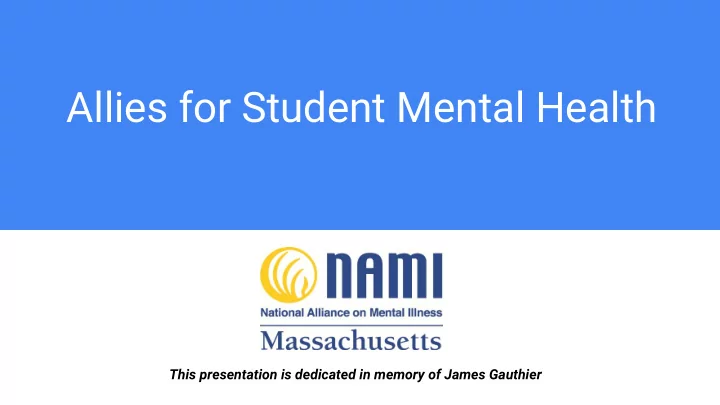

Allies for Student Mental Health This presentation is dedicated in memory of James Gauthier
Why this topic? Why today?
Goals 1. Allies for Student Mental Health 2. Resources from NAMI
Outcomes of The Allies for Student Mental Health Presentation ● From the Peer: understanding what it is like to live with mental health conditions ● From the Clinician: the signs and symptoms of common mental health conditions in children ● From the Educator: classroom tools/strategies you can use right away ● From the Parent: how to help your most vulnerable students succeed
Peer’s Perspective
How would you describe the supports in your district?
Clinician’s Perspective
What are Mental Health Conditions? Dysregulation of mood, thoughts, and behaviors that affects a child’s ability to function appropriately. It appears as difficulties with: ● emotional readiness ● organizational skills self esteem, stigma ● ● sleep ● appetite ● thinking, concentrating, and processing information
Risk Factors That Contribute to Mental Illness ● Biological Factors ○ e.g., genetics, complications with pregnancy/delivery ● Environmental Factors ○ e.g., severe trauma, poverty, neglect and abuse, early loss, bullying, death of loved one, divorce, poor support system ● Psychological Factors e.g., temperament, personality factors ○
The Facts about Mental Health and Youth ● 20% of 13-18 year old live with a mental health condition ● 17% of high school students seriously consider suicide ● 50% of 8-15 year olds with a mental health condition don’t receive treatment ● The average delay between onset of symptoms and treatment is 8-10 years
Risks of Not Intervening ● 50% of students ages 14+ with a mental illness drop out of high school ● 70% of youth in juvenile justice systems have a mental health condition ● More than 90% of youth who die by suicide had one or more mental health conditions
Early Identification and Intervention are Essential to Recovery Research has shown that early recognition, intervention, and treatment of mental disorders make a positive difference in a teen’s life – potentially preventing a suicide attempt or a death by suicide.
Depression: Signs and Symptoms 4% prevalence in children, increases to 17% in adolescents Typical Depression Signs Specific to Children ● depressed mood ● irritability and oppositionality changes in appetite, sleep, energy complaints of physical symptoms ● ● loss of interest in activities increase in school absences ● ● ● poor concentration ● extreme sensitivity to rejection, ● loss of motivation correction, or failure suicidal thinking ● guilt ●
Anxiety: Signs and Symptoms heightened sense of arousal ● sleep difficulties, fatigue ● restlessness ● excessive worry ● headaches or stomachaches ● irritability ● avoidant behavior ● poor concentration ●
ADHD: Signs and Symptoms Neurodevelopmental disorder characterized by: ● inattention (trouble focusing, disorganized, trouble finding or completing assignments) ● hyperactivity (difficulty sitting still, fidgety) ● impulsivity (impatient, disruptive, easily frustrated)
Oppositionality and Aggression Oppositionality and aggression can be seen in children exhibiting: ● Depression ● Anxiety Attention issues ● Trauma ● ● Intellectual disabilities ● Autism Spectrum Disorder Modeling behaviors from family ● Medical issues e.g. seizures ● Most importantly, not all oppositionality and aggression is premeditated.
Trauma: Signs and Symptoms ● severe anxiety ● feelings of anger, detachment or dissociation ● intrusive memories, nightmares, flashbacks ● avoidance of distressing memories ● hypervigilance, exaggerated startle response ● difficulty with concentration ● sleep disturbance ● withdrawn, quiet, disengaged
Psychosis: Signs and Symptoms ● hallucinations ● delusions ● disjointed thoughts ● decline in self care ● mood & behavior changes
Educator’s Perspective
Why You Have an Important Role “Every child who winds up doing well has had at least one stable and committed relationship with a supportive adult.” https://www.gse.harvard.edu/news/uk/15/03/science-resilience
Why Does Mental Health Matter? Mental health can affect your student’s: ● Ability to learn ● Attendance ● Relationship with peers ● Physical health
What is Your Role and Why is It Important? ● You spend a lot of time with your students. ● You are an expert observer. ● Information about behaviors at school can help identify mental health issues earlier. ● You and your school provide a critical link to referral for an evaluation.
What Can You Do? We give educators strategies for... ● Creating a safe classroom ● Connecting with students! ● Developing accommodations ● Communicating with families
Work as a Team ● Connect with families Identify an advocate for the child in school ● ● Work with the treatment team Create a safe space within the school ● ● Encourage mind/body wellness
Four Steps to Early Intervention 1. Know the warning signs 2. Reach out and share concerns 3. Provide resources and supports 4. Implement strategies to promote student success and wellness
Family Perspective
How NAMI Can Help Local Affiliates Call 617-704-NAMI (6264)
Courage and compassion in action: I can... I will...
Thank you Children with mental health challenges struggle to cope with the demands of school. However, building an empathic relationship in a safe, flexible, and supportive environment can make a lifelong difference.
Recommend
More recommend